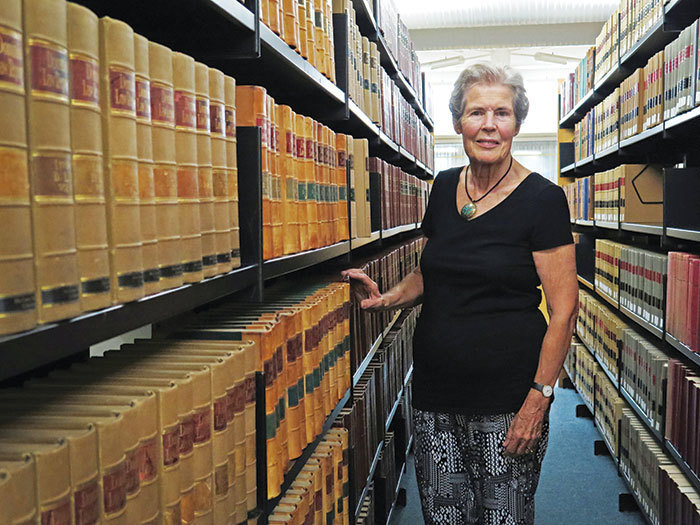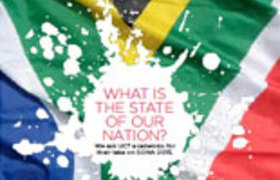Black Sash: The silent sisterhood that haunted a government
27 July 2015
Mary Burton's first Black Sash protest stand was in Kalk Bay on a fine day in 1965, after the government had threatened to proclaim the historic fishing village 'white' under the Group Areas Act. Poster in hand, Burton and a group of women stood silently alongside the main road, black sashes draped across their bodies, the target of jeers – and the occasional murmur of encouragement.
She recalls how the background sound of the waves and the cries of fishermen bringing in their catch had underscored the "cruelty and stupidity" of breaking up the lives of those who depended on the sea for their livelihood.
Raised in Argentina, Burton joined the Black Sash barely four years after arriving here in 1961, the year South Africa left the Commonwealth. She was newly married to South African Geoffrey Burton, whom she had had met while studying in London.
She recalls how hard it was for her to process the apartheid system. Although she worked at the Service Dining Rooms' soup kitchen for indigent people, she realised far more was needed. But it was the magnitude and significance of the Group Areas Act in particular that galvanised her into joining the Black Sash.
"In later years, protest stands and marches were restricted and prohibited, and breaking the rules led to attacks and arrests for many," she said. "Black Sash women stood in all parts of the country in lone vigil, holding their posters, using the last bit of legal space left to them.
"And even when those single stands were legal, the women were often subjected to abuse and intimidation."
New book on Black Sash
Fifty years after joining the organisation, Burton is about to publish The Black Sash (Jacana Media), a book on the organisation's history and contribution to democracy. Its release will coincide with activities around Women's Day on 9 August.
It's a neat intersection.
Generations of women have been the backbone of an organisation Nelson Mandela once called "the conscience of white South Africa".
Writing on the Sash's 60th anniversary, Daily Maverick journalist Marianne Thamm recounts the organisation's beginnings in 1955 "over a cup of tea by six middle-class white women outraged by the then-government's attempts to remove 'coloured' citizens from the voter's roll".
These women launched the Black Sash's forerunner, the Women's Defence of the Constitution League. Their key strategies were "silent sisterhood" and "blacksashing" (wearing a black sash) during silent protest vigils. (The name 'Black Sash' was adopted as a reference to the sashes they wore or draped over a replica of the 1910 constitution, which robbed the majority of South Africans of the right to vote.)
This silent protest included "haunting" cabinet ministers; standing at the entrances of places they were expected to appear – railway stations, airports, or official functions. In Parliament's public gallery, the women were forced to remove the sashes, but devised ways of replacing them – for instance, by wearing long black gloves – infuriating National Party members when they glanced up. Outside Parliament, others stood with bent heads, holding placards protesting against unjust laws.
Hands-on activists
The group was also hands-on, grappling with the actualities of racial segregation, influx control, migrant labour, censorship, detention without trial, and the states of emergency.
For Burton, three areas stand out.
First, the Sash advice offices worked to meet the daily needs of thousands of people, initially under the pass laws and later under the burden of poverty and deprivation.
Second, the protest and advocacy work helped keep alive the public voice of opposition to injustice. "For decades, this had demonstrated in a tangible way the view of white people who were prepared to stand against apartheid."
And third, the group was determined to spotlight how poverty and violence affected women's lives.
During the 1970s there was growing interest in Steve Biko's Black Consciousness Movement, and many white liberals were concerned about the dangers of nationalism, whether black or white, says Burton.
"Yet Black Sash members worked with Steve Biko and the Black Community Programmes, and saw in the movement the value of developing independence and self-worth in the quest for liberation."
Personal story
The publisher's blurb describes the book as "a story of hard work and dedication, of small victories won little by little against the odds, of personal courage in the face of injustice and repression, of vision, compassion and caring. It is a uniquely South African story".
Burton's personal story is closely entwined.
"Joining the Black Sash influenced the course of my life."
For one, it brought her to UCT in 1979 as a mature student (she was 39).
"One of the most important realisations was that I did not know enough about South African history and political theory."
She took four majors: political science, comparative African law, social anthropology – and English, "for the sheer love of it".
"I went back to the Black Sash much better equipped to play my part in it."
She was its national president in the tumultuous years between 1986 and 1990. The State of Emergency was in force; the ANC had put out the call to make the townships ungovernable, and there were rolling national school boycotts.
"The Black Sash found itself swept up in the mounting pressure for an end to apartheid, and played its part in protesting, monitoring and recording the drastic response from the authorities," Burton commented.
"In the increasing violence, the Sash longed for peace, but understood that this meant working for justice. A new generation of members joined the older ones, but numbers remained small."
As the work of the advice offices continued to grow, new outreaches carried their work into the wider field, opposing the forced removals of settled communities; even those far from the urban areas.
Redefined role after 1994
In the year after South Africa's watershed elections, Burton took on a new role: one of 17 commissioners on the Truth and Reconciliation Commission, serving on its Human Rights Committee.
It was then that she began thinking about writing a history of the Sash; many NGOs were redefining their roles in a changing society. She had a vast collection of documents and newspapers that she augmented with records from the UCT and Wits archives, and recorded interviews with Black Sash members around the country.
In 2008, thanks to Professor Brenda Cooper, Burton became an honorary research associate in the Centre for African Studies (CAS), first under Cooper's directorship and then under Professor Harry Garuba.
"This allowed me to deal with the mass of my accumulated papers, and to benefit from the contact with staff and students of the CAS."
But the book is not only a chronicle. Burton saw that the Sash's metamorphosis over six decades could serve as a model for other NGOs.
"I thought it would be useful to describe the often agonising process the Black Sash went through in 1994, resulting in the closure in 1995 of the membership-driven, broad-focus movement, and its replacement by a tighter, professionally managed advice office and advocacy organisation.
"I still think it is amazing that the process worked – and that the Black Sash continues its work today."
Story by Helen Swingler. Photo by Michael Hammond.
 This work is licensed under a Creative Commons Attribution-NoDerivatives 4.0 International License.
This work is licensed under a Creative Commons Attribution-NoDerivatives 4.0 International License.
Please view the republishing articles page for more information.
Front page
Opinions
Faculty Focus - Centre for Higher Education Development (CHED)
News
Editorial
Letter to the Editor
Previous Editions










